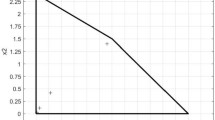Abstract
The problem of confining the trajectory of a linear discrete-time system in a given polyhedral domain is addressed through the concept of (A, B)-invariance. First, an explicit characterization of (A, B)-invariance of convex polyhedra is proposed. Such characterization amounts to necessary and sufficient conditions in the form of linear matrix relations and presents two major advantages compared to the ones found in the literature: it applies to any convex polyhedron and does not require the computation of vertices. Such advantages are felt particularly in the computation of the supremal (A, B)-invariant set included in a given polyhedron, for which a numerical method is proposed. The problem of computing a control law which forces the system trajectories to evolve inside an (A, B)-invariant polyhedron is treated as well. Finally, the (A, B)-invariance relations are generalized to persistently disturbed systems.
Similar content being viewed by others
References
Bitsoris, G., Positively Invariant Polyhedral Sets of Discrete-Time Linear Systems, International Journal of Control, Vol. 47, pp. 1713–1726, 1988.
Benzaouia, A., and Burgat, C., Regulator Problem for Discrete-Time Systems with Nonsymmetrical Constrained Control, International Journal of Control, Vol. 48, pp. 2441–2451, 1988.
Hennet, J. C., Discrete-Time Constrained Linear Systems, Control and Dynamic Systems, Edited by C. T. Leondes, Academic Press, San Diego, California, Vol. 71, pp. 157–213, 1995.
Blanchini, F., Feedback Control for Linear Time-Invariant Systems with State and Control Bounds in the Presence of Disturbances, IEEE Transactions on Automatic Control, Vol. 35, pp. 1231–1234, 1990.
Bitsoris, G., Existence of Positively Invariant Polyhedral Sets for Continuous-Time Linear Systems, Control Theory and Advanced Technology, Vol. 7, pp. 407–427, 1991.
Castelan, E. B., and Hennet, J. C., Eigenstructure Assignment for State-Constrained Linear Continuous-Time Systems, Automatica, Vol. 28, pp. 605–611, 1992.
Wonham, W. M., Linear Multivariable Control: A Geometric Approach, Springer Verlag, New York, New York, 1985.
Basile, G., and Marro, G., Controlled and Conditioned Invariants in Linear System Theory, Prentice-Hall, Englewood Cliffs, New Jersey, 1992.
Witsenhausen, H. S., Sets of Possible States of Linear Systems Given Perturbed Observations, IEEE Transactions on Automatic Control, Vol. 13, pp. 556–558, 1968.
Glover, J. D., and Schweppe, F. C., Control of Linear Dynamic Systems with Set-Constrained Disturbances, IEEE Transactions on Automatic Control, Vol. 16, pp. 411–423, 1971.
Bertsekas, D. P., Infinite-Time Reachability of State-Space Regions by Using Feedback Control, IEEE Transactions on Automatic Control, Vol. 17, pp. 604–613, 1972.
Gutman, P. O., and Cwikel, M., Admissible Sets and Feedback Control for Discrete-Time Linear Systems with Bounded Control and States, IEEE Transactions on Automatic Control, Vol. 31, pp. 373–376, 1986.
Keerthi, S. S., and Gilbert, E. G., Computation of Minimum-Time Feedback Control Laws for Discrete-Time Systems with State-Control Constraints, IEEE Transactions on Automatic Control, Vol. 32, pp. 432–435, 1987.
Blanchini, F., Ultimate Boundedness Control for Uncertain Discrete-Time Systems via Set-Induced Lyapunov Functions, IEEE Transactions on Automatic Control, Vol. 39, pp. 428–433, 1994.
Gutman, P. O., and Cwikel, M., An Algorithm to Find Maximal State Constraint Sets for Discrete-Time Linear Dynamical Systems with Bounded Control and States, IEEE Transactions on Automatic Control, Vol. 32, pp. 251–254, 1987.
Schrijver, A., Theory of Linear and Integer Programming, John Wiley and Sons, Chichester, England, 1987.
D'Alessandro, P., Dalla Mora, M., and De Santis, E., Techniques of Linear Programming Based on the Theory of Convex Cones, Optimization, Vol. 20, pp. 761–777, 1989.
DÓrea, C. E. T., and Hennet, J. C., On (A, B)-Invariance of Polyhedral Domains for Discrete-Time Systems, Proceedings of the 35th IEEE Conference on Decision and Control, Kobe, Japan, pp. 4319–4324, 1996.
DÓrea, C. E. T., and Hennet, J. C., (A, B)-Invariance Conditions of Polyhedral Domains for Continuous-Time Systems, Proceedings of the 1997 European Control Conference, Brussels, Belgium, WE-A-El, Vol. 3, 1997.
DÓrea, C. E. T., and Hennet, J. C., Computation of Maximal Admissible Sets of Constrained Linear Systems, Proceedings of the 4th IEEE Mediterranean Symposium on New Directions on Control and Automation, Maleme, Greece, pp. 286–291, 1996.
Blanchini, F., and Sznaier, M., Persistent Disturbance Rejection via Static State Feedback, IEEE Transactions on Automatic Control, Vol. 40, pp. 1127–1131, 1995.
DÓrea, C. E. T., and Hennet, J. C., A Geometric Approach to the l 1 -Linear Control Problem, Proceedings of the 36th IEEE Conference on Decision and Control, San Diego, California, Vol. 2, pp. 1552–1557, 1997.
Author information
Authors and Affiliations
Rights and permissions
About this article
Cite this article
Dórea, C.E.T., Hennet, J.C. (A, B)-Invariant Polyhedral Sets of Linear Discrete-Time Systems. Journal of Optimization Theory and Applications 103, 521–542 (1999). https://doi.org/10.1023/A:1021727806358
Issue Date:
DOI: https://doi.org/10.1023/A:1021727806358




